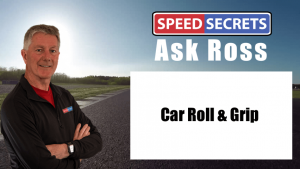 Q: “I have read all your books and subscribed to Speed Secrets Weekly. Correct me if I am wrong but I picked up that one needs to be “smooth” and not try to transfer too much weight to have the most amount of grip – inside wheels less grip, thus overall grip less. I have always tried to apply this with my racing. I have also read up a lot about setups, etc., currently busy with roll centers. What I have been picking up is that a lower roll center (lever arm further away from center of gravity) will give more “roll,” and in turn, will provide “more” grip. Unless I am missing something the roll center theory is almost the opposite of the driving theory. Am I missing something? If so, please help.”
Q: “I have read all your books and subscribed to Speed Secrets Weekly. Correct me if I am wrong but I picked up that one needs to be “smooth” and not try to transfer too much weight to have the most amount of grip – inside wheels less grip, thus overall grip less. I have always tried to apply this with my racing. I have also read up a lot about setups, etc., currently busy with roll centers. What I have been picking up is that a lower roll center (lever arm further away from center of gravity) will give more “roll,” and in turn, will provide “more” grip. Unless I am missing something the roll center theory is almost the opposite of the driving theory. Am I missing something? If so, please help.”
A: I’m not an expert on roll centers, but I have read “all” the books and spent time talking with engineers about geometry, setup, etc. Where this gets confusing is comparing roll with load transfer. If the car rolls (leans) more, there is actually less load transfer, and therefore the inside tires do not lose as much load and grip. That’s why more roll leads to more grip (obviously, there are limits to this, and too much will also reduce grip, especially when there is so much roll that the geometry change is so great that camber is negatively impacted).
Again, it’s easy to confuse roll with load transfer, but in a way, they’re the opposite. Think of a go-kart, which has no suspension, and therefore the body roll is non-existent – but it will pick the inside tires up off the track surface from the load transfer. A softly sprung car will roll a lot, but keep load on the inside tires.
From this, you’d think that a softly sprung car will handle better than a stiffly sprung one. That’s true up to a point – due to the lesser load transfer – but a soft car is not very responsive to a driver’s input. It’ll feel lazy. Finding the balance between reduced load transfer and responsiveness is what tuning the handling is all about.
